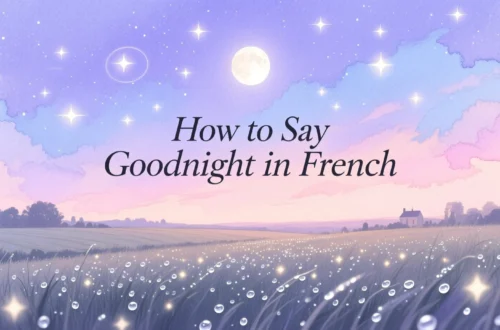Picture clinking glasses with friends in a cozy Munich beer hall, raising a hearty “Prost!” to celebrate life’s moments. That simple word, “cheers,” carries a universal burst of joy, yet it transforms across cultures, reflecting each society’s unique way of toasting.
Whether it’s a lively “Salud!” in a Mexican cantina or a warm “Kanpai!” in a Tokyo izakaya, the term for “cheers” captures our shared desire to connect and celebrate, flavored by local traditions.
Let’s embark on a global journey to explore how people say “cheers” in different languages and what these toasts reveal about their cultures.
Reference Table: “Cheers” in Different Languages
| Language | Word/Phrase | Cultural/Linguistic Insight |
|---|---|---|
| French | Santé | Means “health,” wishing well-being to all. |
| Spanish | Salud | Also means “health,” used widely in Latin America and Spain. |
| Italian | Cin cin | Mimics the sound of clinking glasses, used joyfully. |
| German | Prost | Means “cheers” or “to health,” common in beer halls. |
| Mandarin | Gānbēi (干杯) | Literally “dry cup,” encouraging a full drink. |
| Hindi | Cheers | Borrowed from English, often used in urban settings. |
| Japanese | Kanpai (乾杯) | Means “dry cup,” a spirited call to empty glasses. |
| Korean | Geonbae (건배) | Similar to “dry cup,” used in lively gatherings. |
| Arabic | Fī siḥḥatik (في صحتك) | Means “to your health,” used in over 20 countries. |
| Swahili | Maisha marefu | Means “long life,” a heartfelt toast in East Africa. |
| Zulu | Impilo enhle | Translates to “good health,” used in South Africa. |
| Yoruba | Alafia | Means “peace” or “health,” a warm wish in Nigeria. |
| Maori | Kia ora | Means “be well,” a versatile greeting and toast. |
| Hawaiian | Kāmau | Means “to drink,” tied to communal celebrations. |
| Cherokee | Donadagohvi | Means “let’s drink together,” emphasizing unity. |
European Languages: Toasts of Joy and Health
European languages express “cheers” with terms that blend celebration and goodwill. For instance, in French, “santé” (health) is a warm wish for well-being, used in both elegant wine tastings and casual gatherings. Meanwhile, Spanish speakers say “salud” (health), a versatile toast heard from Mexico to Madrid, often paired with clinking glasses. Additionally, Italian uses “cin cin,” mimicking the sound of glasses touching, reflecting Italy’s playful approach to festivities. In German, “Prost” (to health) is a hearty call in beer halls, embodying Germany’s love for communal celebrations. Thus, these toasts highlight Europe’s focus on health and joy, from poetic French to exuberant German traditions.
Asian Languages: Raising Glasses in Harmony
Asia’s linguistic diversity shapes vibrant ways to say “cheers,” often tied to camaraderie. For example, in Mandarin, “gānbēi” (dry cup) encourages finishing one’s drink, reflecting China’s lively banquet culture. In Hindi, urban settings often borrow “cheers” from English, but traditional toasts may invoke blessings like “swasthya” (health). Similarly, Japanese uses “kanpai” (dry cup), a spirited call to empty glasses, heard in izakayas across Tokyo. In Korean, “geonbae” (dry cup) carries a similar energy, aligning with South Korea’s social drinking culture. Finally, Arabic’s “fī siḥḥatik” (to your health), used in over 20 countries like Lebanon and Egypt, conveys warmth and respect, rooted in the region’s hospitality. These terms showcase Asia’s range, from festive calls to heartfelt wishes.
African Languages: Toasts for Life and Community
In African languages, “cheers” often ties to community and longevity. For instance, Swahili, spoken in over 20 countries like Kenya and Tanzania, uses “maisha marefu” (long life), a heartfelt toast in vibrant gatherings. In Zulu, “impilo enhle” (good health) is a warm wish in South Africa, often shared during celebrations. Similarly, Yoruba’s “alafia” (peace or health) in Nigeria conveys positivity, reflecting the culture’s communal spirit. These terms, used in markets, weddings, or festivals, emphasize shared joy and well-wishing across diverse African settings.
Indigenous & Island Languages: Unity in Celebration
Indigenous and island languages express “cheers” with simplicity and connection. For example, Maori in New Zealand uses “kia ora” (be well), a versatile term for greetings and toasts, reflecting cultural harmony. In Hawaiian, “kāmau” (to drink) is tied to communal feasts, embodying the spirit of aloha. Similarly, Cherokee’s “donadagohvi” (let’s drink together) emphasizes unity in Native American communities. In Samoan, “fa’amanuia” (blessings) is used in Pacific gatherings, highlighting shared joy. Across these cultures, from New Zealand to the Cherokee Nation, “cheers” fosters unity, often tied to traditional rituals.
Cultural Insights: The Evolution of Toasting
Words for “cheers” have evolved with cultural practices. For instance, the English “cheers,” from Old French “chiere” (face, good cheer), spread through colonial influence. In Arabic, “fī siḥḥatik” traces back to medieval hospitality traditions, symbolizing respect. Moreover, in African languages like Swahili, “maisha marefu” reflects ancient blessings for prosperity. In Asia, terms like “gānbēi” and “kanpai” emerged from ceremonial drinking, emphasizing group harmony. These toasts carry histories of trade, ritual, and celebration, uniting people across centuries in shared moments of joy.
Proverbs and Sayings: Wisdom of Celebration
- French: “À la santé, à l’amour, à la vie.” (To health, love, and life.) – Captures the essence of toasting.
- Hindi: “Jeevan anand se bhara ho.” (May life be filled with joy.) – Reflects celebratory optimism.
- Swahili: “Maisha marefu, furaha tele.” (Long life, abundant joy.) – Ties toasts to happiness.
- Japanese: “Kanpai de kokoro ga hitotsu ni.” (With kanpai, hearts unite.) – Emphasizes shared connection.
- Yoruba: “Alafia ni ohun gbogbo.” (Peace is everything.) – Links toasts to well-being.
FAQs
Why do some words for “cheers” sound similar?
Shared linguistic roots (e.g., “salud” and “santé” from Latin) and English’s global influence (e.g., “cheers” in Hindi) create similarities.
What’s the oldest term for “cheers”?
The English “cheers,” from Old French “chiere” (13th century), is among the earliest, evolving into a global toast.
How do cultures shape the term’s use?
Collectivist cultures (e.g., African, Indigenous) use “cheers” to foster group unity, while individualistic cultures (e.g., European) focus on personal goodwill.
Conclusion
From “salud” in Spain to “maisha marefu” in Tanzania, the word for “cheers” weaves a global thread of celebration and connection. Each term, whether the lively “kanpai” in Japanese or the warm “kia ora” in Maori, reflects cultural values while uniting us in joy. Consequently, these toasts remind us that a simple clink of glasses can bridge divides, bringing all people together in shared moments. How do you say “cheers” in your language, and what does it mean to you? Share your stories below—we’d love to hear your toast!





